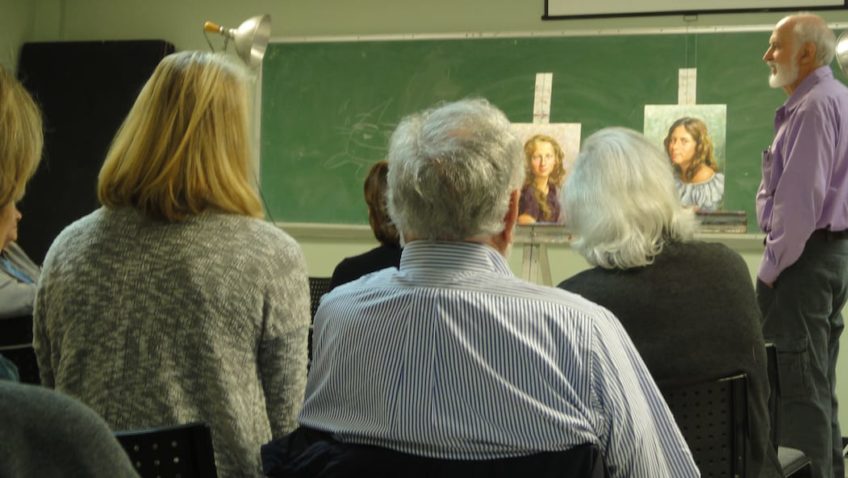By Margaret Ann Garrett
There’s no mandated format at the Portrait Society of Atlanta’s critique sessions. Scheduled only twice a year, every session is unique and is directed by the professional artist sharing his or her experience and opinions.

At the session held on October 24, 2017, Damon Carter began by answering some general questions about his processes and sharing some useful tips. One particular suggestion had a few heads nodding in agreement: “During a commission, establish boundaries with the client right up front.” The consensus was that work goes more smoothly if begun with everyone singing the same tune.
On this particular Fall evening, a number of PSA members brought finished and unfinished pieces for Damon to critique. Below are a few questions, and Damon’s responses, along with some random tips he shared during the evening’s conversation. These are Damon’s answers to questions about his methods:
- How do you start? While he likes to paint on a toned canvas, he doesn’t always do that. Sometimes he starts with a color underpainting for the whole canvas or just part of the canvas. Outdoors, he generally paints on a toned canvas.
- When working from a reference photo, do you rely more on the photo or your imagination for color input? He relies on imagination, and typically will try to push the warm and cool colors.
- What goes through your mind when you’re painting repetitive objects like branches? Be aware of negative spaces and try to work in a variety of shapes and colors.
And more tips from Carter, inspired by work submitted for critique:
- A stroke has more energy in its first lay-down.
- Ask yourself, “How can I suggest this information without spelling everything out?”
- An artist’s style of painting will influence how much detail to include. Wrinkles are natural, but analyze how comfortable your sitter is with them to determine how much detail is enough.
- Leave something out and determine which edges are soft or hard, Note that variety is important.
- Some people don’t seem natural unless they’re smiling. If you must paint teeth, simplify.
- On the challenge of hair, paint in the direction in which it is brushed.
- Always be aware of the light source, and watch values in the shadow areas.
- If you think an area isn’t working but are afraid to make any changes, try putting some clear acetate over the area and roughly paint in the changes on the acetate. This will help you determine whether the changes will be an improvement or a detriment.

If you’ve never attended a PSA critique session because you didn’t have a piece needing critique at that particular time, remember you still can attend. There’s always something you can learn from someone else that might be useful at a later date. Take advantage of the next critique session to ask a successful portrait artist all the questions you’ve always wanted to ask.
For more about Damon Carter, visit his website at damoncarterartist.com.


